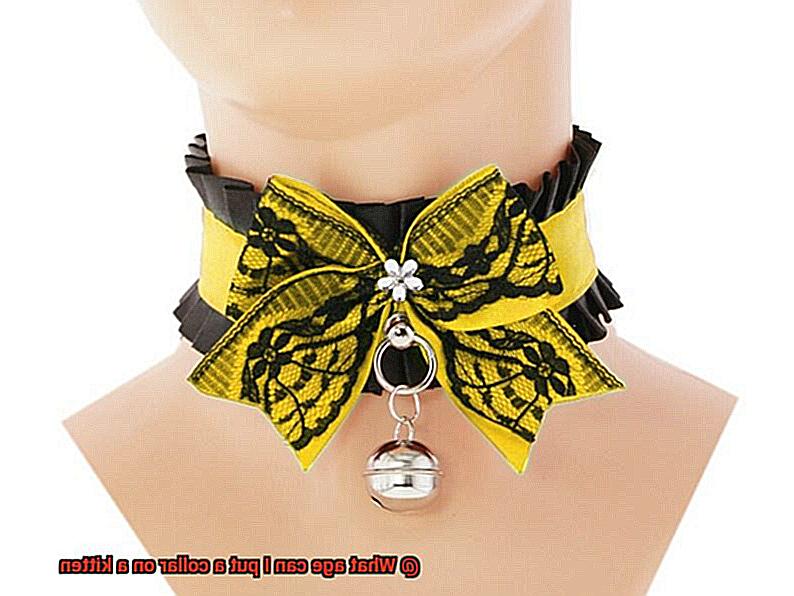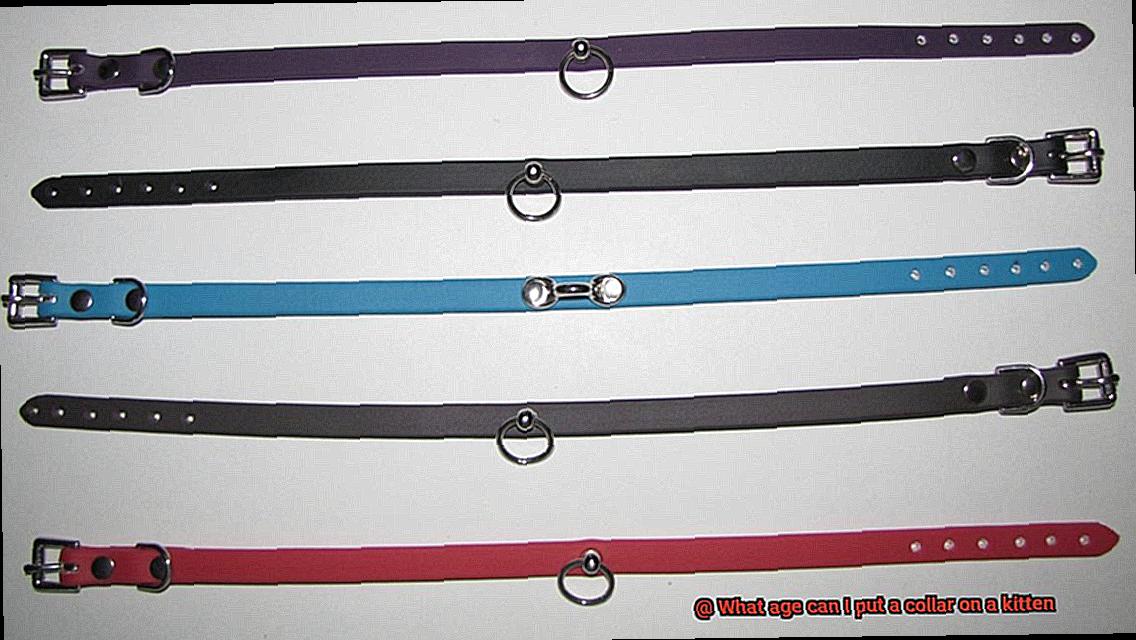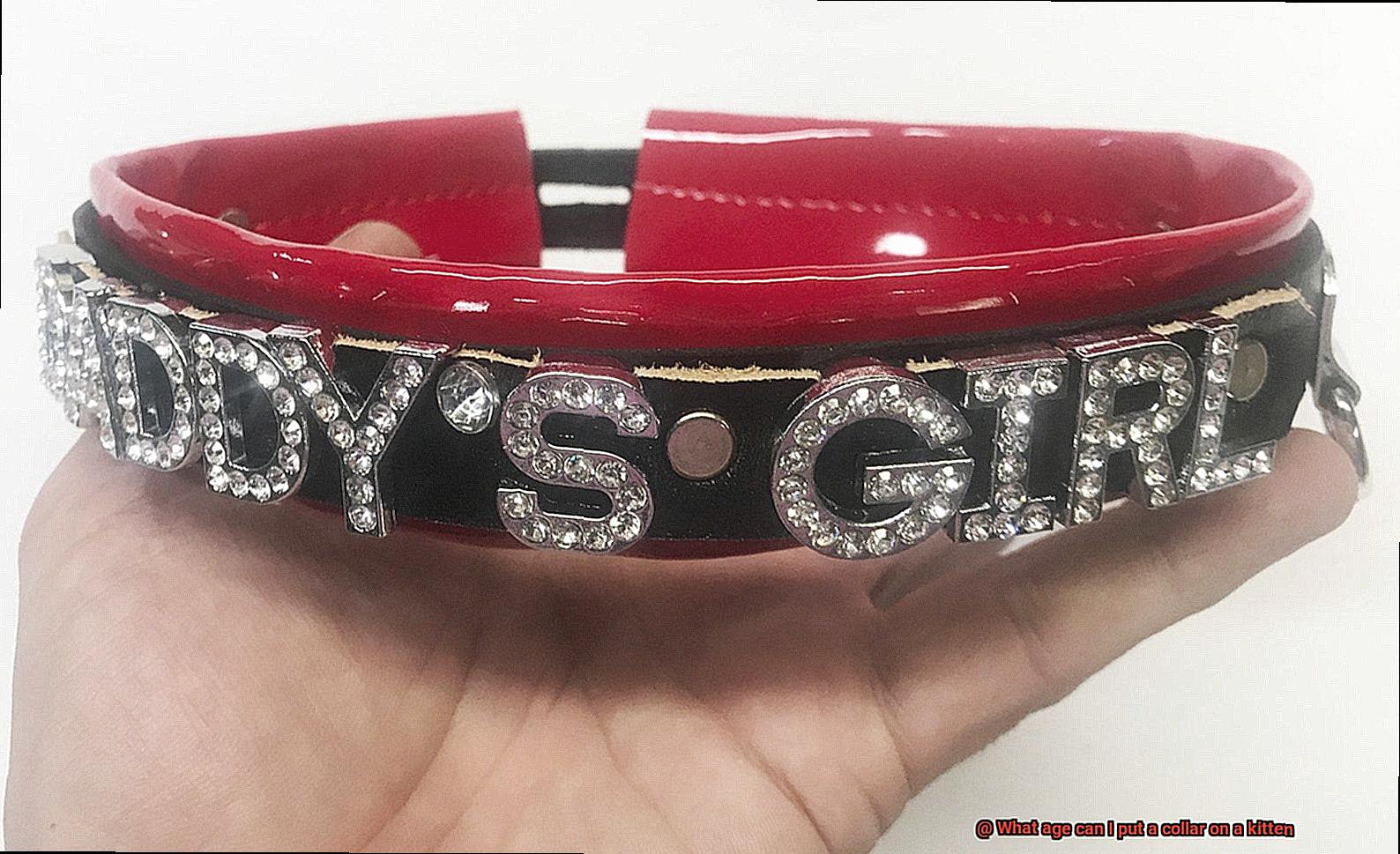Are you a new kitten owner, eager to keep your furry friend safe and secure? If so, you may be wondering when it’s appropriate to put a collar on your little feline. With so many varying opinions out there, it can be tough to know what’s best for your kitten. But fear not. We’re here to help answer the burning question on every new cat parent’s mind: What age can I put a collar on a kitten?
Collars are an excellent way to keep track of your adventurous kitten, especially if they like to explore the great outdoors. However, it’s crucial to ensure that your kitty is old enough and comfortable wearing a collar before you start using one.
In this post, we’ll cover everything from the ideal age for collar use to the different types of collars available. We’ll also address common concerns that new cat owners might have about collars, such as the risk of choking or injury. By the end of this blog post, you’ll have all the information you need to make an informed decision about putting a collar on your beloved kitten.
So let’s get started and find out when it’s safe and appropriate for your furry friend to start wearing their very own stylish collar.
What Age Should You Put a Collar on a Kitten?
One way to do that is by putting a collar on them. But when is the right time to introduce this accessory? The age at which you can put a collar on a kitten varies depending on the individual cat and their development.
Most experts suggest waiting until a kitten is at least 8-12 weeks old before introducing a collar. At this age, kittens have usually been weaned from their mother and have developed enough strength and coordination to handle the weight of a collar.
However, it’s important to assess each kitten’s individual development before deciding when to introduce a collar. Some kittens may be ready earlier or later than this timeframe.
When choosing a collar for your kitten, ensure that it fits snugly but allows room for growth. A collar that is too loose can pose a choking hazard, while one that is too tight can cause discomfort or even injury. You should also consider getting a breakaway collar as they have a safety release mechanism that allows the collar to break free if it becomes caught on something. This minimizes the risk of choking or injury.
It’s essential to monitor your kitten’s behavior and adjust their collar as needed. If they seem uncomfortable or try to remove the collar, it may be too tight or uncomfortable. Take it off and adjust it accordingly.
In summary, here are some key points to keep in mind when deciding when to introduce a collar to your kitten:
- Wait until they are at least 8-12 weeks old
- Assess each kitten’s individual development
- Get a collar that fits snugly but allows room for growth
- Choose a breakaway collar for safety
- Monitor your kitten’s behavior and adjust the collar as needed
Benefits of Wearing a Collar
These accessories offer numerous benefits beyond making your furry friend look cute. As an expert on the topic, let me walk you through some of the benefits of wearing a collar for kittens.
Identification is one of the primary benefits of collars. In the unfortunate event that your kitten gets lost, a collar with your name and phone number attached will make it easier for anyone who finds them to return them to their rightful owner. Additionally, collars serve as a signal to others that the cat has an owner, which can prevent them from being taken or harmed by strangers.
Collars can also aid in training your kitten. If your kitten has a habit of scratching or biting, you can use a collar as a way to train them by making them uncomfortable whenever they engage in undesirable behavior. A collar with a bell attached can also help you keep track of your pet’s whereabouts.
Finally, collars can be used as a fashion statement. With so many types of collars available in the market such as leather, nylon, or fabric, you can choose one that matches your pet’s personality. You can even add accessories like bows or pendants to make them stand out.

Types of Collars for Kittens
Kittens are curious creatures that love to explore their surroundings. But as a pet owner, it’s essential to keep them safe and secure. One way to do this is by getting them a collar.
However, with so many types of collars available, it can be overwhelming to choose the right one for your kitten. In this post, we’ll examine five different types of collars and how to select the ideal one for your furry friend.
Buckle Collars:
Buckle collars are the most common type of collar used for kittens. They come with a buckle that fastens around the kitten’s neck and can be adjusted for a snug fit. Buckle collars are made from various materials such as nylon, leather, and fabric. These collars are perfect for kittens who are still growing and need a collar that can adjust as they get bigger.
Breakaway Collars:
Breakaway collars are designed to release if your kitten gets caught on something, preventing choking or getting stuck. These collars have a safety release mechanism that allows the collar to break apart under pressure. They’re ideal for kittens who are still learning to explore their surroundings and are prone to getting into mischief.
Stretch Collars:
Stretch collars are made from an elastic material that allows them to stretch if your kitten gets caught on something. This type of collar is perfect for active kittens who like to climb and explore. The elasticity of the collar allows your kitten to move freely without feeling restricted.
Safety Collars:
Safety collars are similar to breakaway collars but have an additional safety feature that prevents the collar from coming off too easily. These collars have a limited amount of give so that they stay on securely but will still break away under pressure. They’re great for kittens who like to play rough and need extra protection.
GPS Tracking Collars:
GPS tracking collars are perfect for kittens who like to wander outdoors or tend to get lost easily. These collars have a small device attached that allows you to track your kitten’s location using your smartphone or computer. They’re perfect for peace of mind when your kitten is outside exploring.
How to Measure Your Kitten for the Right Size Collar
Kittens are curious creatures who love to explore their surroundings. As a responsible pet parent, it’s important to ensure that your kitten is safe and secure, especially when they venture outside. One way to do this is by getting them a collar. However, choosing the right size collar for your kitten can be a daunting task. Here are five sub-sections to help you measure your kitten for the right size collar:
Wait until your kitten is at least 12 weeks old before introducing a collar.
Before you start measuring your kitten’s neck, it’s important to wait until they’re at least 12 weeks old. This will give them enough time to grow and develop without any discomfort or risk of injury.
Use a flexible measuring tape or a piece of string and a ruler.
To measure your kitten’s neck, you’ll need a flexible measuring tape or a piece of string and a ruler. Place the tape or string around your kitten’s neck, just below their jawline where their collar would rest. Make sure it’s snug but not too tight, allowing for about two fingers’ width of space between the tape and your kitten’s neck.

Choose the appropriate collar size.
Once you’ve determined the circumference of your kitten’s neck, refer to sizing charts provided by various pet retailers to choose the appropriate collar size. It’s important to choose a collar that is neither too loose nor too tight, as either option can be uncomfortable or dangerous for your kitten.
Opt for a lightweight and adjustable collar made from soft materials.

When selecting a collar for your kitten, opt for a lightweight and adjustable collar made from soft materials such as nylon or leather. These materials are gentle on your kitten’s skin and won’t cause any irritation or discomfort.

Regularly inspect your kitten’s collar.
It’s crucial to inspect your kitten’s collar regularly to ensure it remains in good condition and is not causing any discomfort or irritation. As your kitten grows, it may be necessary to adjust the collar size or replace it altogether to ensure a proper fit. This will not only keep your kitten safe and comfortable but also provide identification in case they wander away from home.

Safety Features to Look For in a Collar

When choosing a collar for your kitten, it is essential to prioritize their safety. While collars can be useful for identification purposes, they can also pose a risk to your kitten’s safety if not chosen carefully. Here are some essential safety features to look for in a collar:
First and foremost, a breakaway or safety buckle collar is an absolute must-have. This type of collar is designed to release itself in the event of it becoming caught on something, preventing strangulation. These collars have a quick-release mechanism that releases the collar when pressure is applied. This small but crucial feature can make all the difference.

Stretchy material is another feature to look out for when choosing a collar for your kitten. Stretchy collars can help prevent choking hazards by allowing the collar to stretch when pulled tight. This feature is especially useful for kittens who are still learning to navigate their surroundings and may get themselves into sticky situations.
Adjustable size is another crucial aspect to consider when choosing a collar. Ensure that you choose an adjustable collar so you can guarantee it fits your kitten comfortably. A collar that is too loose can easily get caught on objects, while one that is too tight will be uncomfortable and potentially dangerous.
A reflective material or strip on the collar is another key feature to consider. This makes it easier for your kitten to be seen by cars and other pedestrians at night, reducing the risk of accidents.
Lastly, choose a collar made from soft material such as nylon or leather. A soft collar ensures that your kitten’s neck will not become irritated or uncomfortable, guaranteeing their comfort and happiness.
Tips on Getting Your Kitten Used to Wearing a Collar
Teaching your kitten to wear a collar can be a challenging task, but it’s also one of the most important things you can do to keep them safe. Whether you’re planning on taking them outside or just want to make sure they can be easily identified if they get lost, a collar is an essential accessory for any feline friend. Here are five tips to help you get started:
Start Early
Like most things in life, the earlier you start, the easier it will be. Kittens can start wearing collars as early as eight weeks old. This way, they’ll become accustomed to having something around their neck and won’t feel as uncomfortable when they’re older.
Choose the Right Collar
Picking the right collar is crucial. Look for a lightweight and adjustable collar that fits snugly but not too tightly around your kitten’s neck. A breakaway or safety feature is also important in case your kitten gets snagged on something.
Make It Fun
Introduce the collar during playtime to help your kitten associate it with positive experiences. Let them play with it or put it on and take it off while playing together so that they feel comfortable and enjoy the process.
Gradual Introductions
Don’t expect your kitten to wear the collar all day from the beginning. Start by letting them wear it for short periods and gradually increase the length of time. This way, your kitten won’t feel overwhelmed and will adjust more easily to wearing the collar.
Positive Reinforcement
Whenever your kitten wears their collar without trying to remove it, praise and reward them with treats or affection. This positive reinforcement will encourage them to continue wearing their collar without any fuss.
Risks of Putting On a Collar Too Early
While collars are an essential tool for pet safety, they can also pose risks if not used correctly, especially with kittens. Here are some potential dangers and how to avoid them when putting a collar on your kitten too early.
Firstly, one of the most significant risks is the potential for strangulation. Kittens’ necks are delicate, and if the collar is too tight or too loose, it can become caught on something, resulting in choking or even death. Therefore, it’s crucial to ensure that the collar fits correctly and is not too tight or loose.
Secondly, curious kittens can get themselves into all sorts of mischief and may end up injuring themselves if their collar gets caught on an object. Injuries can range from simple scratches to more severe damage to their neck or other parts of their body.
Additionally, putting a collar on a kitten too early can cause unnecessary stress and anxiety for them. Kittens are still adjusting to their new surroundings and may find the weight and sensation of a collar uncomfortable or frightening. This can lead to behavioral problems such as hiding, excessive meowing, or aggression.
To avoid these risks, it’s crucial to wait until your kitten is old enough and comfortable with wearing a collar before introducing one. In the meantime, you can take other measures to ensure their safety. Keeping them indoors will prevent them from getting into trouble outside, while providing plenty of toys and scratching posts will keep them entertained at home.
When It’s Time to Take Off the Collar
While collars are a great way to identify your cat and keep them safe, it’s important to know when it’s time to take off your kitten’s collar. Here are some factors to consider:
- Comfort Level: Your kitten’s collar should not be too tight or too loose. If they are scratching at the collar excessively or trying to remove it themselves, it could be a sign that they are uncomfortable or the collar is causing irritation. In such cases, it’s time to remove the collar.
- Proper Fit: As your kitten grows, you may need to adjust the collar accordingly. However, if your kitten has outgrown their collar and it is becoming too tight, it’s important to remove it and replace it with a larger one. A snug but not constricting fit is ideal.
- Living Environment: If your kitten is an indoor cat and there is no risk of them getting lost outside, then there may be no need for them to wear a collar. Collars can sometimes get caught on furniture or other objects in the home, causing potential harm to your kitten. Consider removing the collar if your cat doesn’t need it for identification purposes.
- Wear and Tear: Regularly checking your kitten’s collar for any signs of wear and tear is crucial. If the collar becomes frayed or damaged, it may be time to replace it or remove it altogether. A damaged collar can break, leading to potential harm or loss of identification.
tmK7_kVN5X0″ >
Conclusion
To sum up, the question of when to put a collar on a kitten can be answered by taking into account their individual development and comfort. While most experts recommend waiting until a kitten is at least 8-12 weeks old before introducing a collar, it’s crucial to evaluate each kitten’s unique situation. Collars have benefits beyond identification, such as aiding in training and making a fashion statement. There are various types of collars available, including buckle collars, breakaway collars, stretch collars, safety collars, and GPS tracking collars. To ensure your kitten’s safety, it’s essential to choose the right size and prioritize safety features like breakaway or safety buckles.
Introducing your kitten to wearing a collar requires starting early and making it fun with gradual introductions and positive reinforcement. Putting on a collar too soon can pose risks like strangulation or injury and cause unnecessary stress for kittens. Lastly, knowing when to remove the collar involves considering comfort level, proper fit based on growth rate, living environment, wear and tear of the collar.
By following these guidelines carefully, you can keep your furry friend safe while looking stylish in their new accessory. It’s important to measure your kitten correctly to select the appropriate size collar that fits snugly but allows room for growth. Additionally, prioritizing safety features like reflective material or strips and soft materials can help prevent accidents.
Remember that getting your kitten used to wearing a collar takes patience and persistence.







